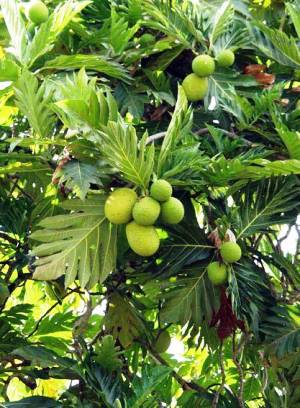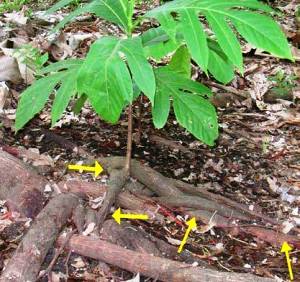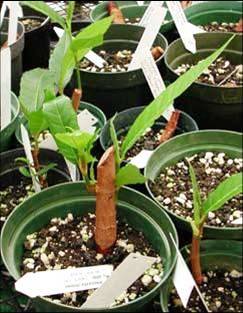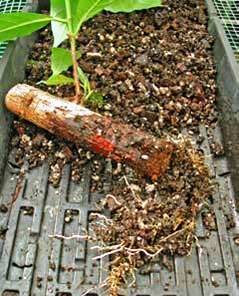Regeneration guidelines for breadfruit
|
View regeneration guidelines in full (in PDF) |
The information on this page was extracted from:
Ragone D. 2008. Regeneration guidelines: breadfruit. In: Dulloo M.E., Thormann I., Jorge M.A. and Hanson J., editors. Crop specific regeneration guidelines [CD-ROM]. CGIAR System- wide Genetic Resource Programme, Rome, Italy. 7 pp.
Before reading the regeneration details for this crop, read the general introduction that gives general guidelines to follow by clicking here.
Introduction
Breadfruit (Artocarpus altilis (Parkinson) Fosberg) is a long-lived, tropical, evergreen tree primarily grown for its starchy carbohydrate fruit. Breadfruit has been cultivated in the Pacific Islands for nearly three millennia and was domesticated from A. camansi Blanco (breadnut) in New Guinea and nearby islands. A few seedless breadfruit Polynesian cultivars were distributed to the Caribbean, along with breadnut, in the late 1700s and are now widely distributed in the tropics. In most regions of the world breadfruit varieties are seedless triploid forms (2n=84). In some parts of the Pacific, diploid (2n=56) varieties are also found, some of which produce fertile seeds while others are less fertile (Ragone 2001; Zerega et al. 2004). Low fertility in diploids probably resulted from continuous vegetative propagation accumulating genetic abnormalities (somatic mutations). Breadfruit is outcrossing but produces seedless fruit parthenocarpically if there is no fertilization. This crop is maintained ex situ as clonal trees in field genebanks. Trees can live 80 years or more.
 An abundance of breadfruit on a Polynesian variety in the breadfruit collection at the National Tropical Botanical Garden, Hawaii. (photo: Jim Wiseman) |
Choice of environment and planting season
Limits of adaptation
Breadfruit is adapted to a wide range of ecological conditions.
- Altitude: grows best in equatorial lowlands below 600–650 m but is found at elevations up to 1550 m.
- Latitude: the latitudinal limits are approximately 17°N and S but the range extends to the Tropics of Cancer and Capricorn in maritime climates.
- Rainfall: a mean annual rainfall of 1000–3000 mm or greater
- Temperature: 15–40°C; optimum 21–32°C
- Soil: prefers deep, fertile, well-drained, light and medium soils with pH 6.1–7.4.
- Depending on the variety, can tolerate coastal and shallow sandy soils of coral atolls.
Planting season
Plant at the onset of the rainy season and irrigate as needed during the first 1–3 months of establishment.
Preparation for regeneration
Breadfruit is clonally propagated using root shoots or root cuttings. Vegetative propagation is required for seedless varieties and preferred for seeded varieties. Seeds are rarely used because seedlings are not true to type.
When to regenerate
- As trees age, become crowded and unhealthy.
- To produce plants for distribution.
Selection of planting material
- Collect root shoots and cuttings after the fruiting season and when the tree is in an active vegetative stage. This is when carbohydrate levels in the roots are at their highest.
- Breadfruit roots tend to spread and can intermingle with those of adjacent trees so follow a root back to the source tree to make sure it is from the desired parent tree.
 Surface roots and root sucker used for vegetative propagation of breadfruit. Large arrows indicate where the sucker should be severed. Small arrows point to a suitable, healthy, well-formed root. (photo: Diane Ragone) |
Preparation of root shoots
- Collect healthy shoots (see photo) when they are at least 20–25 cm tall and the stem has become woody and is producing lobed leaves. Shoots up to 1 m tall can be used.
- Cut the attached root 10–15 cm on either side of the shoot and carefully remove the shoot from the soil. Use a sharp machete or clippers to sever the shoot from the parent tree and to facilitate wound healing.
- Trim the leaves to reduce transpiration. On taller shoots, excise the tip at a 45-degree angle at a height of 15–30 cm as the shoot tip tends to die back and new growth develops from buds along the stem.
- The success rate of directly transplanting shoots to another location is low, around 25%. The percentage of successful rooting and new vegetative growth in the nursery ranges from 50 to 90%. Grow root shoots under nursery conditions for at least 3–6 months until they are large enough for field planting.
Preparation of root cuttings
- Select healthy, undamaged roots that are growing just beneath the surface of the soil and carefully excavate them. Do not use surface roots because they tend to dry out and are less successful. Look for roots with small rounded bumps (adventitious buds) on the surface which will develop into new shoots (see photo).
- Use roots 1.5–6 cm in diameter (3–4 cm for best results). Removing roots larger than 6 cm can damage the tree as the wounded area will heal more slowly.
- Use a sharp machete or clippers to sever the root. The remaining attached root will often develop a root shoot at the cut end.
- Cut harvested roots into 10–25 cm sections.
- Wash and scrub root cuttings to remove soil and discard any pieces that are damaged or misshapen. Treat with fungicide to prevent root rot. Hormone treatment is not required but standard hormone mixes can be used according to the manufacturer’s recommendation.
Raising root shoots / root cuttings
- Place root shoots and cuttings in a propagating bed, flats, or individual pots and label each piece with its accession number (see photo below left).
- Space 10–15 cm apart in a row, with 15–20 cm between rows in beds or flats.
- Use well-drained potting media or clean, washed silica sand with coir dust or sawdust (2:1 ratio). Do not use beach sand because it is too saline and alkaline.
- Place cuttings either horizontally (lightly covered with media) or at a 45 degree angle with the upper quarter exposed.
- Keep cuttings shaded (up to 60% shade) and moist, but not wet; misting is recommended and the roots should never be allowed to dry out.
- The percentage of rooting ranges from 30 to 85% (photo photo below right).
- Shoots begin to develop from adventitious buds after 3–4 weeks.
- When shoots are 20–25 cm tall with their own roots, usually in 4–6 months, carefully uproot and transplant the cutting into a 1–2 gallon pot; use a well-drained media (e.g. potting mix with perlite or volcanic cinder, clean local loamy or sandy soil) and fertilize sparingly, at half the manufacturer’s recommendations.
- Keep plants in partial shade and weed free.
- Grow to a size of 0.6–1.6 m over 6–9 months and then plant in the field.
- If plants are to be field planted in full sun, gradually move to full sun conditions in the nursery for about 2 months to condition them to the site conditions. Keep plants moist and do not expose to strong wind.
 |
 |
|
Root suckers and root cuttings in potting media in shadehouse, developing new buds and shoots. (photo: Diane Ragone) |
Healthy new feeder roots developing on an excised root cutting. (photo: Jim Wiseman) |
Field selection and preparation
- Breadfruit can be grown on a variety of soil types but does best in well-drained sandy loam or clay loam soils.
- Trees may shed their fruit and leaves and eventually die if the soil remains excessively wet or waterlogged.
Method of regeneration
Planting layout, density and distance
- Plant 1–3 trees of each accession 12–15 m apart in the field.
Planting method
- Trim back the lower leaves by one-half to two-thirds to reduce transpiration. Do not remove or damage the growing point where new leaves develop.
- Protect from wind and excessive heat during transport.
- Dig a hole as deep as the container and twice as wide, add a small amount of slow-release balanced N-P-K fertilizer to the bottom of the hole and cover with soil.
- Carefully remove the tree from the container to prevent damage to the root system and place it in the hole.
- Add soil to no higher than the level of the plant in the pot, add compost and water well.
- Close to 100% success rate can be expected.
Crop management
Weed management
- Mulching young plants helps to preserve soil moisture, maintain a steady supply of nutrients and control weeds around the root system.
- Avoid herbicide use around the base of the tree as it can cause damage if it comes in contact with the surface roots or tender trunk.
Irrigation
- If the weather is dry, irrigate for the first 1–3 months of establishment. Deep irrigation is important to encourage a deep root system.
Common pests and diseases
- Contact plant health experts to identify the symptoms of the likely pest and diseases and the appropriate control measures.
- Breadfruit is relatively free of pests and diseases. Snails and mealy bugs can be a problem on young plants and over-watering in the nursery can result in fungal dieback.
Pest and disease control
- Follow good nursery practices (e.g. monitoring to control pests when they first appear, no over-watering or over-fertilizing). Use insecticidal soaps, sprays, or fungicides sparingly when needed, following manufacturer’s recommendations.
Others
- Protect young trees from cattle, goats, horses and other animals that eat the bark and tender shoots.
Monitoring accession identity
Once the tree is mature and bears fruit, compare general fruit and leaf characters with the original mother plant to ensure that the regenerated plant was obtained from the desired parent tree.
Documentation of information during regeneration
Collect the following information during regeneration:
- Regeneration (nursery) site name and map/GPS reference
- Name of collaborator
- Accession number(s)
- Type of propagating material (e.g. root shoot, root cutting)
- Nursery planting date
- Survival rate of propagating material
- Nursery management details (media, watering, fertilizer, weeding, others)
- Field site name and map/GPS reference
- Field conditions (altitude, precipitation, temperature, soil type, others)
- Number of plants established, planting distance
References and further reading
Bioversity International, NTBG. 2009. Key access and utilization descriptors for breadfruit genetic resources. Bioversity International, Rome, Italy; National Tropical Botanical Garden, Hawaii, USA. Available here.
Coronel RE. 1983. Rimas and kamansi. Promising Fruits of the Philippines. University of the Philippines at Los Baños. pp 379–398.
Nakasone HY, Paull RE. 1998. Breadfruit. In: Tropical Fruits. CAB International, Wallingford, UK. pp. 329–334.
Ragone D. 1997. Breadfruit: Artocarpus altilis (Parkinson) Fosberg. Promoting the conservation and use of underutilized and neglected crops. 10. IPGRI, Rome, Italy.
Ragone D. 2001. Chromosome numbers and pollen stainability of three species of Pacific Island breadfruit (Artocarpus, Moraceae). American Journal of Botany 88(4):693–696.
Ragone D. 2006. Artocarpus altilis (breadfruit). In: Elevitch CR, editor. Traditional Trees of Pacific Islands. Permanent Agriculture Resources (PAR), Holualoa, Hawaii. pp 85–100. Available at http://www.traditionaltree.org. Date accessed: 22 July 2008.
Smith NJH, Williams JT, Plucknett DL, Talbot JP. 1992. Tropical Forests and Their Crops. Cornell University Press, Ithaca, NY. pp. 296–303.
Webster SA 2006. The Breadfruit in Jamaica: A Commercial and Horticultural Perspective. Seymour Webster, Port Antonio, Jamaica.
Zerega NJC, Ragone D, Motley TJ. 2004. Complex origins of breadfruit: implications for human migrations in Oceania. American Journal of Botany 91(5):760–766.
Useful web links
The Breadfruit Institute [homepage of the Breadfruit Institute] [online]. Available from: URL: http://ntbg.org/breadfruit/. Date accessed: 22 July 2008
Morton J. 1987. Breadfruit [online]. Available from: URL: http://www.hort.purdue.edu/newcrop/morton/breadfruit.html. Date accessed: 22 July 2008.
Acknowledgement
These guidelines have been peer reviewed by Francis Zee, United States Department of Agriculture (USDA), USA and Bill Raynor, Nature Conservancy, USA.
Comments
- No comments found






Leave your comments
Post comment as a guest